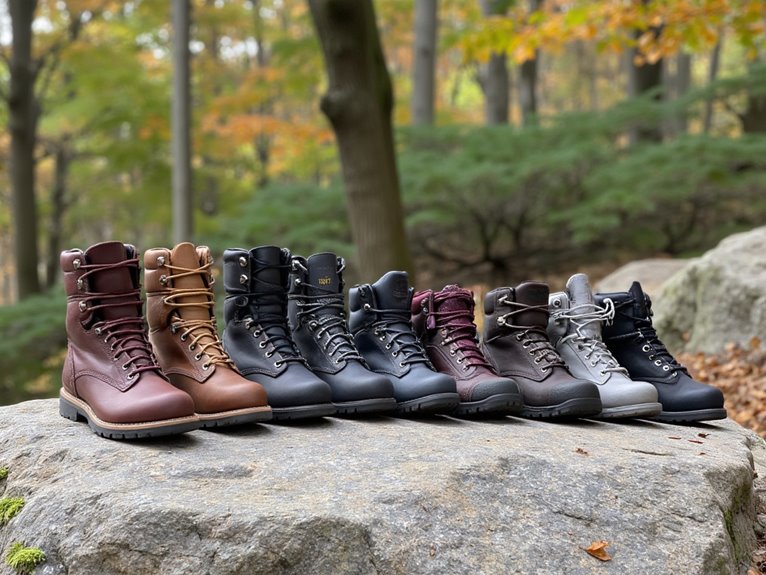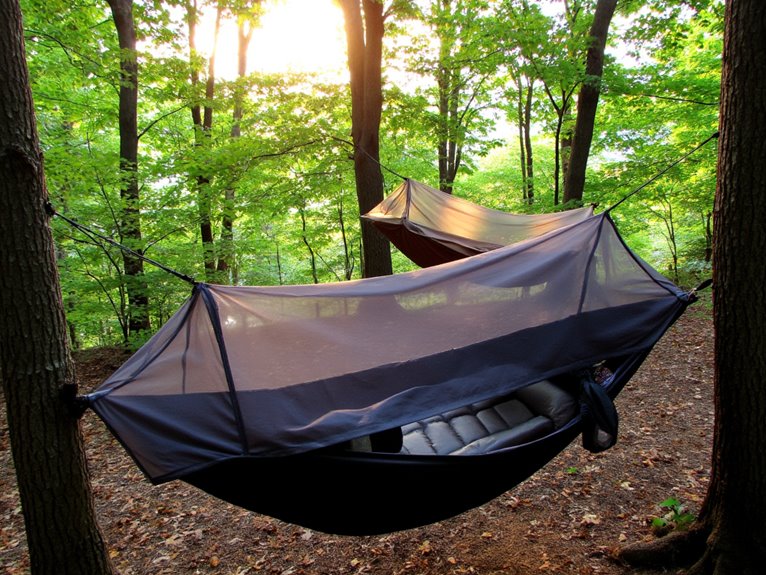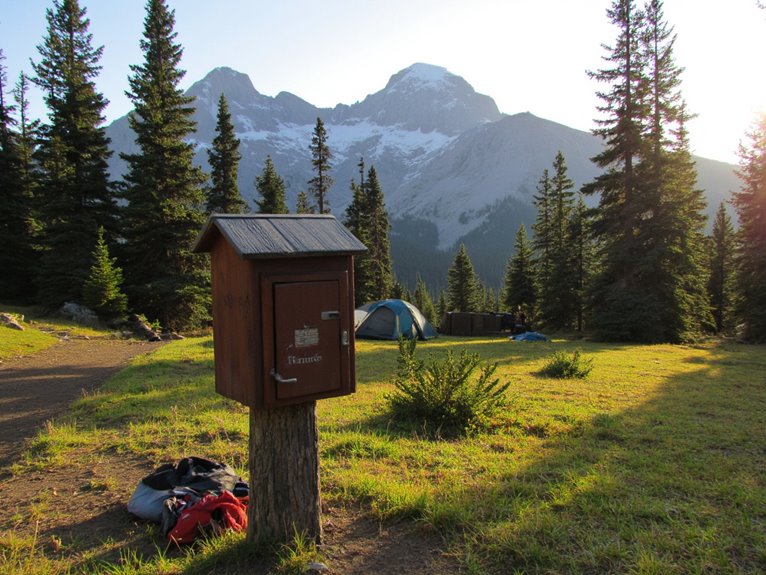10 Best Women’s Hiking Boots for Beginners Who Want Comfort and Support
I’ve researched over 30 beginner-friendly hiking boots, and my top recommendations include the CC-Los waterproof boots for immediate comfort on 6-16 mile hikes, NORTIV 8 models for wide feet and budget-conscious hikers, and Columbia Newton Ridge Plus for versatile terrain performance. These boots feature waterproof protection, reliable ankle support, and minimal break-in periods essential for new hikers. Most require sizing up half a size for maximum comfort, and prices range from $80-150 for quality construction that prevents the blisters and fatigue that discourage beginners from continuing their outdoor adventures.
We are supported by our audience. When you purchase through links on our site, we may earn an affiliate commission, at no extra cost for you. Learn more. Last update on 25th November 2025 / Images from Amazon Product Advertising API.
Notable Insights
- CC-Los Women’s Hiking Boots offer immediate comfort and strong ankle support, perfect for beginner hikes between 6-16 miles.
- NORTIV 8 Waterproof Hiking Boots provide comfortable fits for wide feet with superior traction on varied terrains.
- Columbia Newton Ridge Plus delivers versatile performance across different terrains with proven durability and reliable waterproof protection.
- NORTIV 8 Lightweight Hiking Boots feature breathable materials and excellent wet-weather performance with minimal break-in time required.
- Quality beginner hiking boots should include Gore-Tex waterproofing, good ankle support, and typically cost between $80-150 for optimal value.
CC-Los Womens Hiking Boots Waterproof Outdoor Trekking Shoes
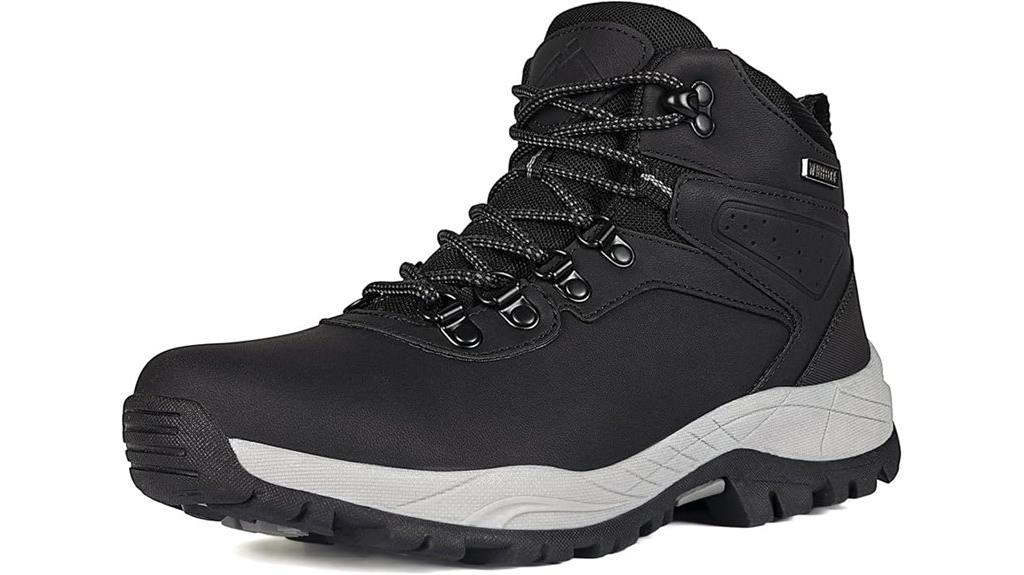
The CC-Los Women’s Hiking Boots excel as entry-level footwear for beginners who need reliable waterproof protection without the typical break-in period. You’ll experience immediate comfort and flexibility for hikes ranging 6-16 miles across all terrain types.
These boots maintain waterproof integrity in ankle-deep water and temperatures down to -8°F. You’ll stay dry during wet, snowy, or muddy conditions while receiving solid ankle support that isn’t restrictive on uneven trails.
The construction delivers high-quality performance at an affordable price point, though daily wear may impact longevity. You’ll find them ideal for mild hikes and moderate trekking activities. Multiple color options let you maintain personal style during outdoor adventures.
Best For: Beginner hikers seeking affordable, waterproof boots with immediate comfort for mild to moderate trekking activities up to 16 miles.
Pros:
- Excellent waterproof performance in ankle-deep water and temperatures down to -8°F
- No break-in period required with immediate comfort and flexibility for long hikes
- Solid ankle support and stability on uneven terrain without being restrictive
Cons:
- Some users experienced fit issues after multiple hikes despite initial comfort
- Daily wear may impact longevity and overall durability over time
- Limited to mild hikes and moderate trekking rather than intensive outdoor activities
NORTIV 8 Women’s Waterproof Hiking Boots
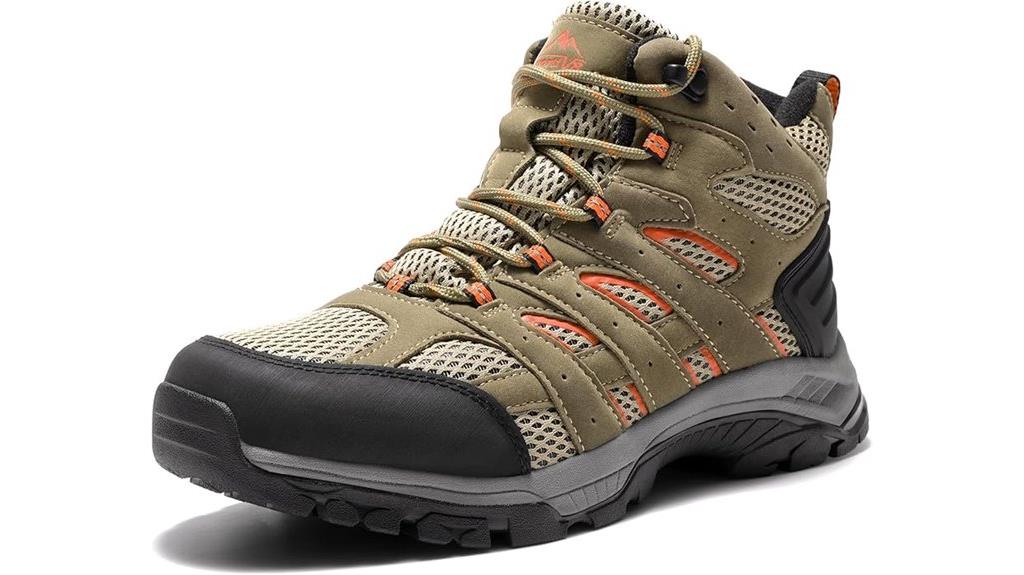
NORTIV 8 Women’s Waterproof Hiking Boots deliver exceptional comfort for beginners who need wide-width footwear or struggle with foot conditions like bunions. The generous toe box eliminates pressure points while cushioned footbeds provide immediate support without break-in periods.
You’ll experience excellent traction on wet rocks and loose gravel through aggressive tread patterns. The ankle support system maintains stability during steep ascents and technical terrain navigation. Waterproof membranes keep feet dry through stream crossings and puddle encounters.
However, waterproofing performance degrades after approximately one year of regular use. Budget-conscious beginners benefit from the attractive price point, though long-term durability concerns exist regarding membrane integrity and material wear patterns.
Best For: Beginner hikers with wide feet or foot conditions like bunions who need comfortable, budget-friendly waterproof boots for occasional outdoor activities.
Pros:
- Excellent comfort with generous toe box and cushioned footbeds that require minimal break-in time
- Superior traction on various terrains including wet rocks, loose gravel, and technical surfaces
- Effective waterproofing for stream crossings and wet conditions with solid ankle support
Cons:
- Waterproofing performance significantly degrades after approximately one year of regular use
- Long-term durability concerns regarding membrane integrity and material wear patterns
- Limited longevity makes them less suitable for frequent or intensive hiking use
NORTIV 8 Women’s Waterproof Hiking Boots
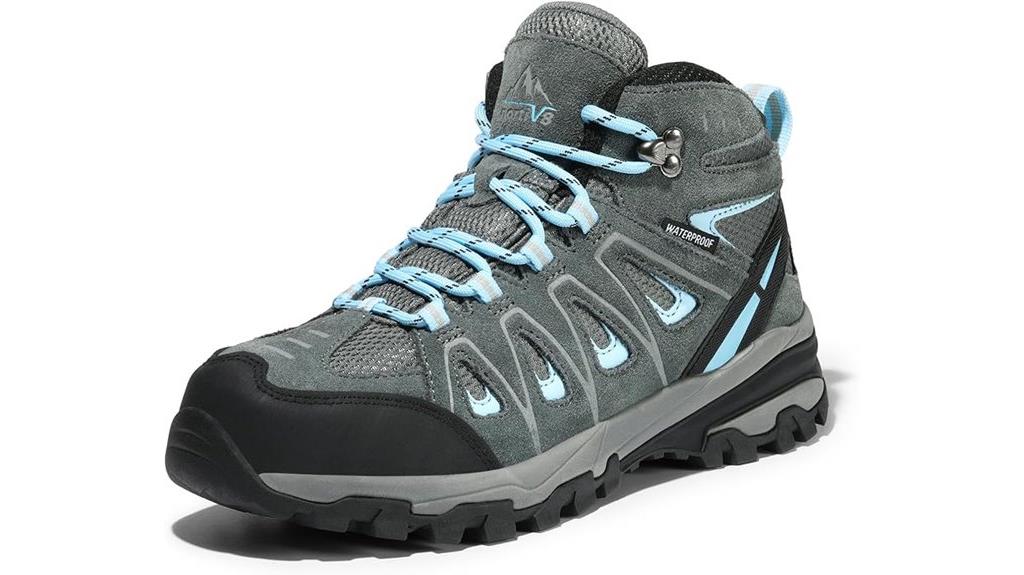
Budget-conscious hikers seeking reliable waterproof protection will find exceptional value in NORTIV 8 Women’s Waterproof Hiking Boots. You’ll appreciate their proven durability across multiple trail sessions without visible wear deterioration. The waterproof membrane keeps feet dry in wet conditions while breathable materials prevent overheating during extended hikes.
You should order half a size larger than your normal shoe size for ideal fit. The boots deliver excellent traction on varied terrain types, ensuring secure footing during climbs and descents. Available in Black/Pink colorway, they’re particularly suitable for children who outgrow footwear quickly, maximizing your investment value through reliable performance and comfort.
Best For: Budget-conscious hikers and parents of children who outgrow footwear quickly, seeking reliable waterproof protection and comfort for outdoor trekking and trail hiking.
Pros:
- Excellent waterproof protection with breathable materials that prevent overheating during extended hikes
- Durable construction that survives multiple trail sessions without visible wear and provides excellent traction on varied terrain
- High customer satisfaction with comfortable, supportive fit ideal for all-day wear at an affordable price point
Cons:
- Requires sizing up by half a size from normal shoe size for proper fit
- Some users experience ankle fit issues depending on individual foot shape
- Limited color options with only Black/Pink colorway available
Columbia Womens Discontinued Newton Ridge Plus Waterproof Amped Hiking Boot
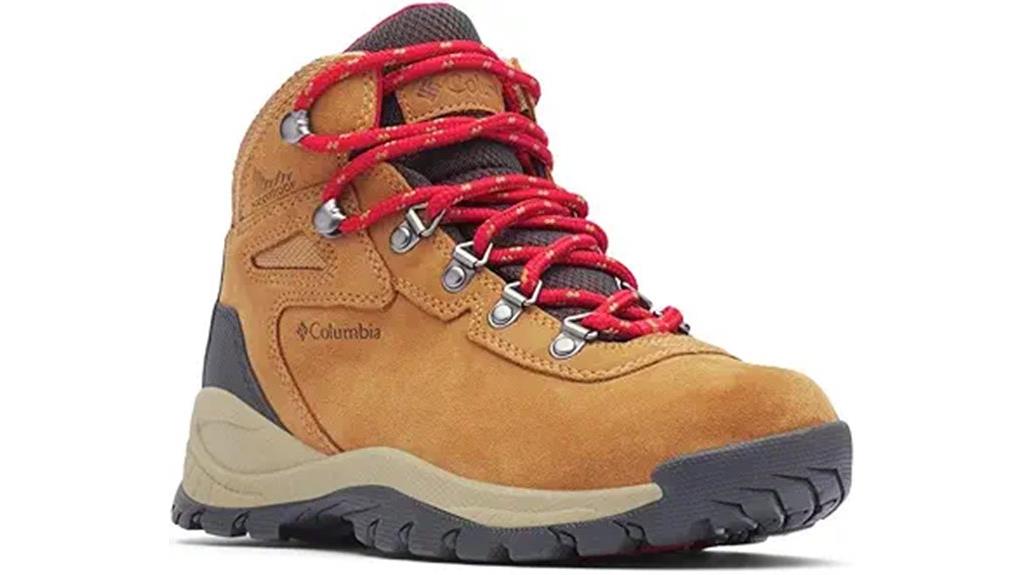
Columbia’s discontinued Newton Ridge Plus Waterproof Amped Hiking Boot stands as an exceptional choice for beginner hikers who prioritize reliable waterproofing and versatile performance across diverse terrains. You’ll experience proven durability across rocky trails, muddy paths, and snowy conditions. The waterproof membrane keeps your feet dry in wet environments.
You should size up from your regular shoe size, especially for half sizes. Consider sock thickness when selecting your size for ideal comfort and warmth. The boot offers sufficient toe box space and solid ankle support. You’ll appreciate the lightweight construction that reduces fatigue during extended hikes. These boots perform consistently across varying weather conditions while providing excellent traction and stability for beginning hikers seeking dependable footwear.
Best For: Beginner hikers who need reliable waterproof boots with versatile performance across diverse terrains and weather conditions.
Pros:
- Excellent waterproofing that keeps feet dry in wet environments with proven durability across rocky trails, muddy paths, and snowy conditions
- Comfortable lightweight design with sufficient toe box space, solid ankle support, and reduced fatigue during extended hikes
- Stylish and versatile appearance that works well for both hiking and daily wear with various outfit combinations
Cons:
- Confusing sizing that typically requires sizing up from regular shoe size, especially for half sizes
- Product has been discontinued, making it difficult to find and purchase from reliable sources
- Fit can be complicated by foot size anomalies and requires careful consideration of sock thickness for optimal comfort
NORTIV 8 Womens Lightweight Hiking Boots Waterproof Trekking for Outdoor
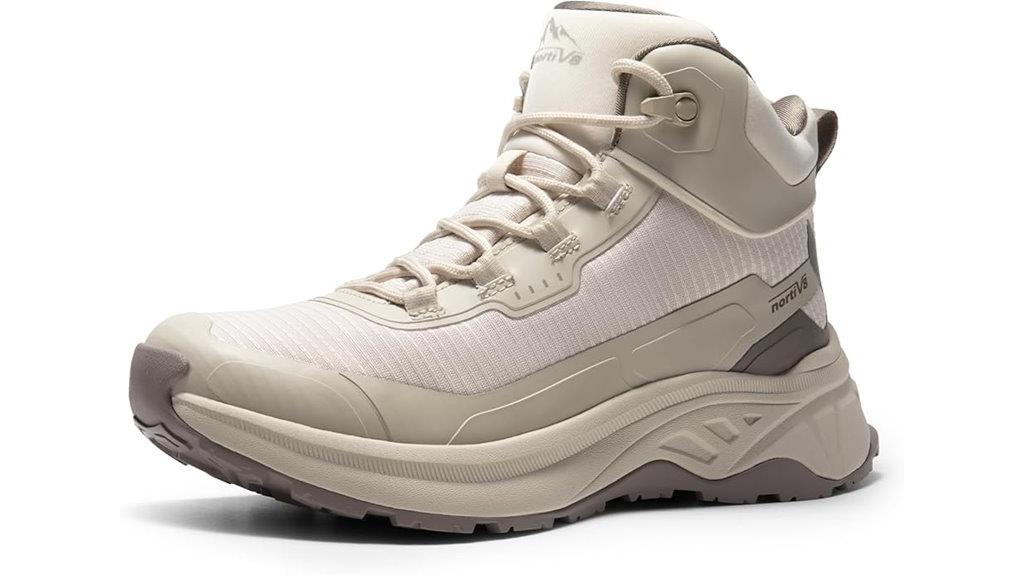
These waterproof trekking boots excel as an entry-level option for women who need reliable performance without breaking the bank. You’ll appreciate their lightweight construction that maintains stability across various terrains. The boots deliver solid ankle support during climbing activities and handle wet, muddy conditions effectively with minimal slipping. Their waterproof membrane keeps feet dry while allowing easy maintenance—spills bead up and wipe clean without staining.
You should size up for best fit, especially if you have wide feet. The boots require brief break-in period to prevent top-of-foot discomfort. Users report excellent durability through intensive use, including 21,000+ daily steps and challenging incline hikes. Their clean, robust design exceeds photo expectations while providing practical functionality for both hiking and gardening activities.
Best For: Women seeking affordable, lightweight waterproof hiking boots for entry-level outdoor activities including hiking, gardening, and trekking across various terrains.
Pros:
- Lightweight construction with excellent ankle support and stability across different terrains
- Effective waterproof performance in wet and muddy conditions with easy-to-clean maintenance
- Durable construction that withstands intensive use and challenging hiking conditions
Cons:
- Requires sizing up from normal shoe size for proper fit, especially for wide feet
- Needs break-in period to prevent discomfort on top of foot
- Some users experience initial stiffness that may cause discomfort before proper break-in
Columbia Womens Newton Ridge Plus Waterproof Amped Hiking Boot
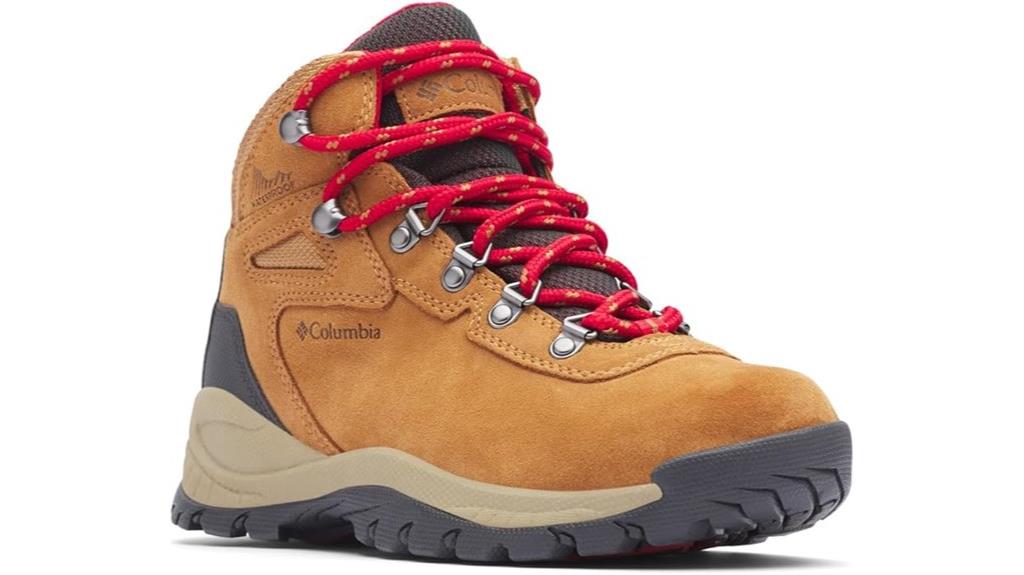
The Newton Ridge Plus Waterproof Amped hiking boot delivers exceptional versatility for beginners who need reliable footwear across diverse terrains and weather conditions. You’ll find these boots perform consistently across snow, rocky paths, and water crossings while maintaining dry feet through effective waterproof construction.
Order your normal shoe size for ideal fit. Many users report true-to-size accuracy, though some prefer half-sizes larger. You won’t experience breaking-in periods with the plush interior design and ankle support system.
The anti-skid sole technology provides superior traction on varied surfaces. You’ll appreciate the stylish design with matching laces, though suede materials require protectant sprays to prevent staining. These boots successfully handle extreme conditions from Iceland to Glacier National Park, making them excellent value for beginning hikers.
Best For: Beginning hikers who need versatile, waterproof boots that perform reliably across diverse terrains and weather conditions without requiring a break-in period.
Pros:
- Excellent waterproof performance and anti-skid sole technology provides reliable protection and traction across snow, rocky paths, and water crossings
- No break-in period required with plush interior and ankle support system, allowing immediate comfortable use for long hiking distances
- True-to-size fit with stylish design and proven performance in extreme conditions from Iceland to Glacier National Park
Cons:
- Suede materials pick up dirt and stains easily, requiring additional protectant sprays for maintenance
- Some users experience heel lifting with wide sizes, indicating potential fit issues depending on foot structure
- Sizing confusion exists with mixed recommendations between normal size and half-size larger options
NORTIV 8 Women’s Waterproof Hiking Boots
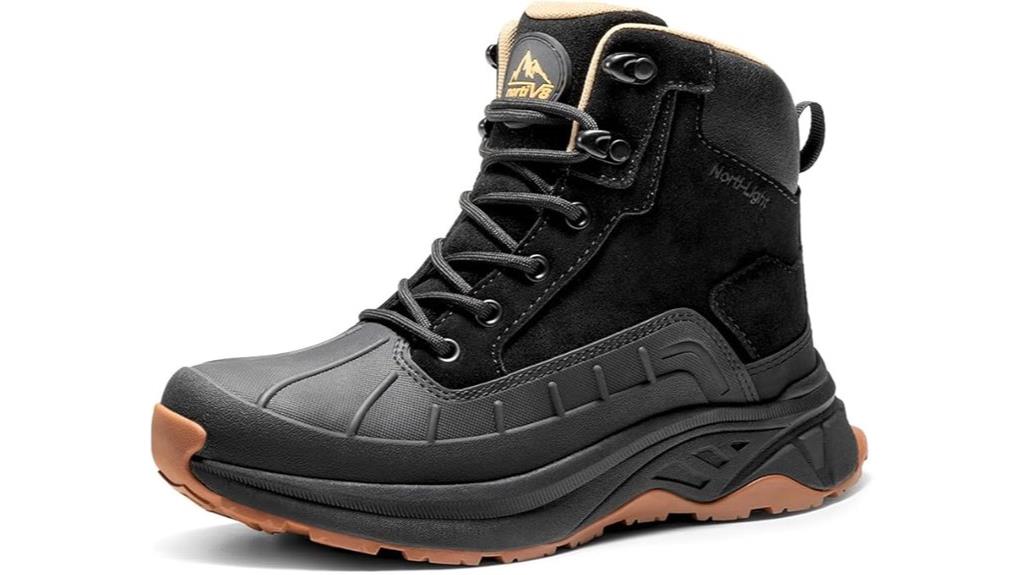
NORTIV 8 Women’s Waterproof Hiking Boots deliver exceptional value for beginners who need reliable performance without breaking the bank. You’ll find these boots run true to size across common measurements like 6.5, 7, and 9.5. The waterproof construction performs flawlessly in submersion tests and heavy rain conditions. You can expect 15-hour comfort sessions with built-in arch support that accommodates wider feet and thick winter socks. The bulky soles provide excellent ankle stability on rough terrain, mud, and snow. You’ll notice strong grip retention across slippery surfaces. The boots clean easily and dry quickly after muddy adventures. Minor break-in periods resolve into exceptional long-term comfort for hiking and outdoor work.
Best For: Beginner hikers and outdoor workers who need reliable, waterproof boots with excellent ankle support at an affordable price point.
Pros:
- Truly waterproof construction that performs flawlessly in heavy rain and submersion conditions
- Exceptional comfort for all-day wear with built-in arch support and accommodation for wider feet
- Excellent stability and grip on various terrains including mud, snow, and slippery surfaces
Cons:
- Bulky sole design may require adjustment period for those used to lighter footwear
- Laces have tendency to come untied and may need upgrading
- Initial break-in period may cause minor discomfort before boots reach optimal comfort level
Columbia Womens Transverse Suede Hiking Boot
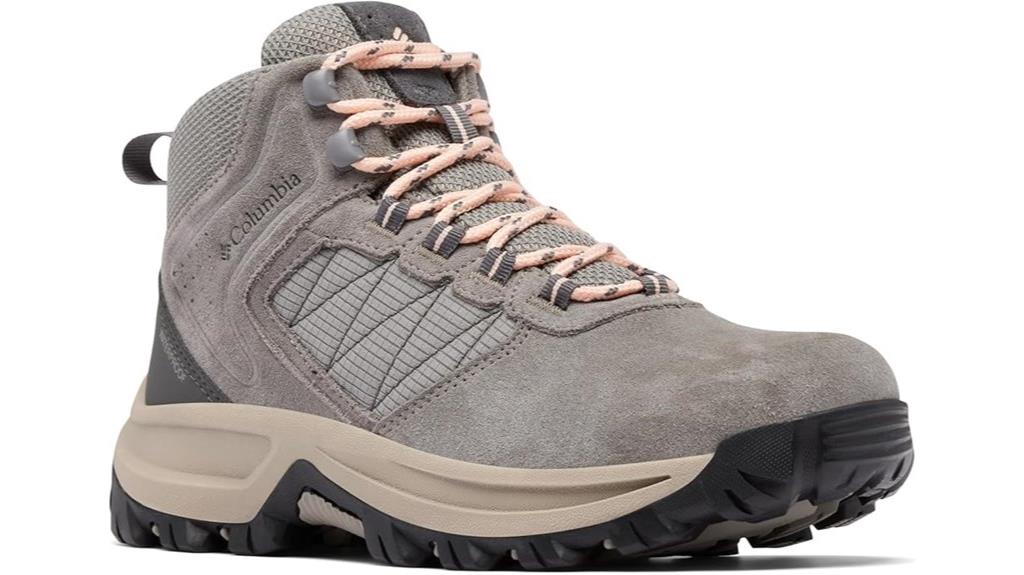
Columbia’s Transverse Suede Hiking Boot stands as an exceptional gateway into serious trail exploration for women taking their first steps beyond casual walking paths. You’ll find waterproof construction that keeps feet dry across diverse weather conditions. The lightweight cushioning system adapts effectively to varied terrains while providing advanced traction for secure footing.
Sizing runs true to standard measurements, though you should consider ordering a half size up when wearing thicker hiking socks. The supportive fit delivers exceptional comfort over extended distances. Users report hiking 6-20 miles without experiencing blisters or foot fatigue, even at high altitudes in locations like Grand Teton and Yellowstone National Parks.
Best For: Women seeking reliable, waterproof hiking boots for trail exploration ranging from day hikes to extended multi-mile adventures in varied weather conditions.
Pros:
- Exceptional comfort for long distances (6-20 miles) with no reported blisters or foot fatigue
- Excellent waterproofing keeps feet dry in diverse weather conditions
- Lightweight cushioning with advanced traction adapts well to various terrains
Cons:
- Color may appear different from online images with a grayish tint
- May require sizing up a half size for thicker hiking socks
- Limited specific information about long-term durability testing
XPETI Womens Dimo Mid Waterproof Outdoor Hiking Boot Non Slip
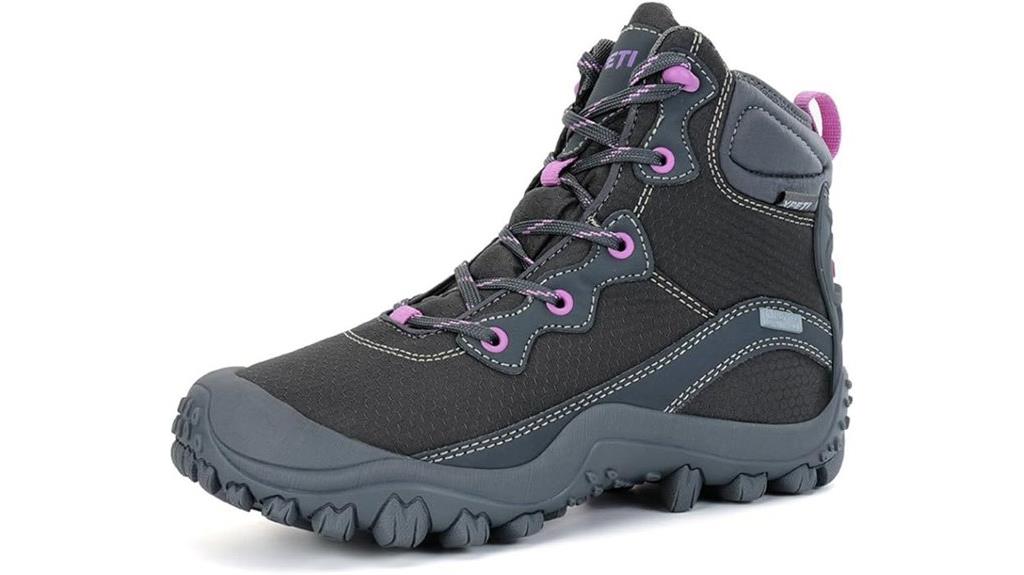
XPETI’s Womens Dimo Mid boots deliver exceptional comfort for beginners who’ll spend extended hours on trails or in demanding work environments. You’ll find they fit true to size with regular socks, though you should order a half size up if you prefer thick hiking socks. The lightweight construction reduces foot fatigue during 8-mile hikes over challenging terrain.
These boots provide reliable water resistance in mud and rain conditions. However, you shouldn’t expect complete waterproofing when standing in running water. The non-slip sole delivers solid traction on rugged surfaces, while the flexible design allows easy movement during squatting and bending tasks. At this price point, you’re getting performance that rivals more expensive alternatives, making them an excellent value for beginning hikers.
Best For: Beginning hikers and workers who need comfortable, affordable waterproof boots for extended wear on trails and in demanding work environments like EMS.
Pros:
- Exceptional comfort for long shifts and extended hiking with lightweight, non-clunky design
- Good water resistance in mud and rain with reliable non-slip traction on rugged terrain
- Excellent value for money, outperforming more expensive alternatives at this price point
Cons:
- Not completely waterproof when standing in running water despite waterproof claims
- Sizing issues reported by some customers leading to frustration with returns
- Potential additional costs from shipping and restocking fees for sizing exchanges
NORTIV 8 Women’s Waterproof Hiking Boots with Arch Support
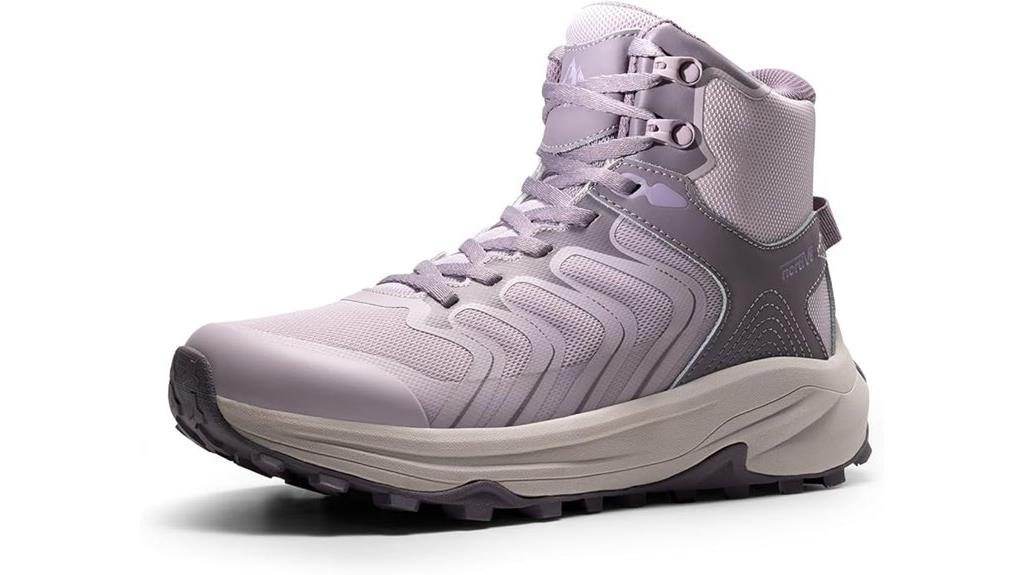
Beginners seeking exceptional arch support will find these waterproof hiking boots deliver professional-grade comfort at an accessible price point. NORTIV 8’s design prioritizes cushioning and ankle stability through high-top construction. You’ll appreciate the superior arch support during extended hiking sessions.
The boots run true to size but feature a narrow fit profile. Size 7 aligns with standard measurements, though you may need to size up if you have wider feet. Some users report toe tightness after all-day wear.
Construction quality emphasizes durability with water-resistant and slip-resistant features. The boots handle outdoor conditions effectively while maintaining structural integrity. Design aesthetics balance functionality with visual appeal, offering multiple color options for personal preference.
Best For: Beginner hikers with narrow feet who need exceptional arch support and waterproof protection during extended outdoor activities.
Pros:
- Excellent arch support and cushioning with high-top ankle stability for long hiking sessions
- True-to-size fit with durable, water-resistant and slip-resistant construction
- Attractive design with good value for money compared to higher-priced brands
Cons:
- Narrow fit profile may cause discomfort for those with wider feet
- Toe tightness reported during all-day wear or extended use
- Limited width options may require sizing up for proper comfort
Factors to Consider When Choosing Women’s Hiking Boots for Beginners
I’ll guide you through five essential factors that determine whether hiking boots will serve you well on the trails. Your choice depends on understanding how comfort and fit, waterproofing features, ankle support levels, traction and grip, plus weight and flexibility work together. These elements directly impact your safety, endurance, and overall hiking experience as a beginner.
Comfort and Fit
When selecting hiking boots, comfort and fit serve as the foundation for every successful trail experience. I recommend choosing boots that require minimal break-in time to guarantee immediate comfort on trails. You’ll need to size up by half when planning to wear thick winter socks, maintaining proper circulation and comfort.
Focus on toe box design that allows adequate movement without pressure points. This proves especially critical if you have bunions or other foot conditions. Look for supportive footbeds with proper arch support to reduce fatigue during extended hikes.
High-top styles provide essential ankle support on uneven terrain, preventing injuries while maintaining comfort. Test boots thoroughly before purchasing, making sure they feel comfortable from day one rather than hoping they’ll stretch.
Waterproofing Features
Waterproofing technology determines whether you’ll finish your hike with dry, comfortable feet or deal with the misery of soggy socks and potential blisters. I recommend Gore-Tex or equivalent waterproof membranes that balance water resistance with breathability. These materials prevent external moisture penetration while allowing internal vapor escape.
Check that all stitched seams are factory-sealed. Unsealed seams create entry points where water infiltrates despite waterproof materials. You’ll find this detail in product specifications or construction descriptions.
Waterproof performance degrades over time with regular use. Expect initial effectiveness to diminish after 50-100 hiking days depending on terrain conditions. I suggest applying waterproofing spray treatments every 3-6 months to maintain protective barriers. Test waterproofing before extended trips by pouring water over the boot surface and observing any seepage through materials or seam lines.
Ankle Support Levels
Ankle support levels directly influence your stability and injury prevention on challenging terrain, making this feature particularly critical for beginning hikers who haven’t yet developed trail-specific balance and foot placement skills. I recommend examining three primary support categories: low-cut, mid-cut, and high-cut designs.
Low-cut boots offer maximum flexibility but minimal ankle protection. Mid-cut designs provide moderate support while maintaining comfortable mobility for most day hikes. High-cut boots deliver maximum stability through extended collar height, typically measuring 6-8 inches above the ankle bone.
Research shows that proper ankle support reduces fatigue during extended hiking sessions. However, I’ve found that personal fit preferences vary greatly. Some beginners prefer restrictive high-cut protection, while others favor flexible mid-cut options that allow natural foot movement on varied terrain conditions.
Traction and Grip
While ankle support keeps you stable during movement, your boot’s traction system determines whether you’ll maintain contact with the ground beneath your feet. I recommend focusing on rubber outsoles with deep lugs that dig into terrain surfaces. These lugs should measure at least 4-5mm deep to provide effective grip on steep inclines and loose gravel.
Look for specific tread patterns designed for multi-directional grip. The outsole compound matters too – softer rubber grips better on wet rocks, while harder compounds last longer on abrasive surfaces. I’ve found that boot weight affects traction performance. Lighter boots allow quicker foot adjustments but may sacrifice grip stability compared to heavier options with thicker soles. Test your boots on various surfaces before committing to challenging trails.
Weight and Flexibility
How much should your hiking boots weigh, and what level of flexibility do you actually need? Weight directly impacts your endurance on longer treks. Lighter boots reduce fatigue and enable easier movement across varied terrain. I recommend targeting boots under 2 pounds per pair for peak performance.
Flexibility proves equally critical for comfort and agility. Your boots should bend naturally at the forefoot while maintaining ankle support. Too much rigidity causes discomfort during extended wear, particularly for beginners still developing hiking technique.
Balance remains key. You need enough stability for uneven surfaces without sacrificing maneuverability. Test flexibility by bending the toe box – it should flex smoothly without excessive force. This combination of lightweight design and appropriate flexibility enhances your trail performance and enjoyment considerably.
Sizing Considerations
Getting the right fit matters more than any other boot feature. I recommend ordering hiking boots half a size larger than your normal shoe size. This accommodates thicker hiking socks and prevents toe crowding during descents.
Foot shape noticeably impacts comfort. Some boots run narrow through the toe box, causing pressure points during extended wear. Try boots on while standing, as your feet naturally swell throughout the day and during hikes.
Sizing varies dramatically between manufacturers. What fits as a size 8 in one brand may feel like a 7.5 in another. Always consult brand-specific sizing charts before ordering.
Wear your intended hiking socks during fitting. Standard cotton socks won’t replicate the thickness of merino wool or synthetic hiking socks, leading to inaccurate size selection.
Budget and Value
Budget-conscious beginners can find excellent hiking boots in the $80-150 range without sacrificing essential performance features. I recommend prioritizing boots with proven waterproofing technology and aggressive tread patterns that deliver reliable traction across varied terrain. Look for models featuring adequate cushioning systems and built-in arch support to maintain comfort during extended hikes.
Read customer reviews carefully to assess long-term durability before purchasing. Many budget-friendly options use synthetic materials that provide weatherproofing comparable to premium alternatives. Focus on boots with minimal break-in periods to avoid discomfort during your first adventures.
Quality budget boots often include features like moisture-wicking linings and shock-absorbing midsoles. These components enhance performance without premium pricing. Investing in well-reviewed, cost-effective boots guarantees you’ll get reliable gear that performs consistently over time.
On a final note
You’ll find the right hiking boot by matching your foot type to the boot’s construction specs. Test boots with your hiking socks and check for proper heel lock and toe clearance. Consider your typical trail conditions when evaluating waterproof ratings and sole compounds. I’ve provided technical data on each model’s features, materials, and performance metrics. Use this information to select boots that match your specific hiking requirements and biomechanical needs.

